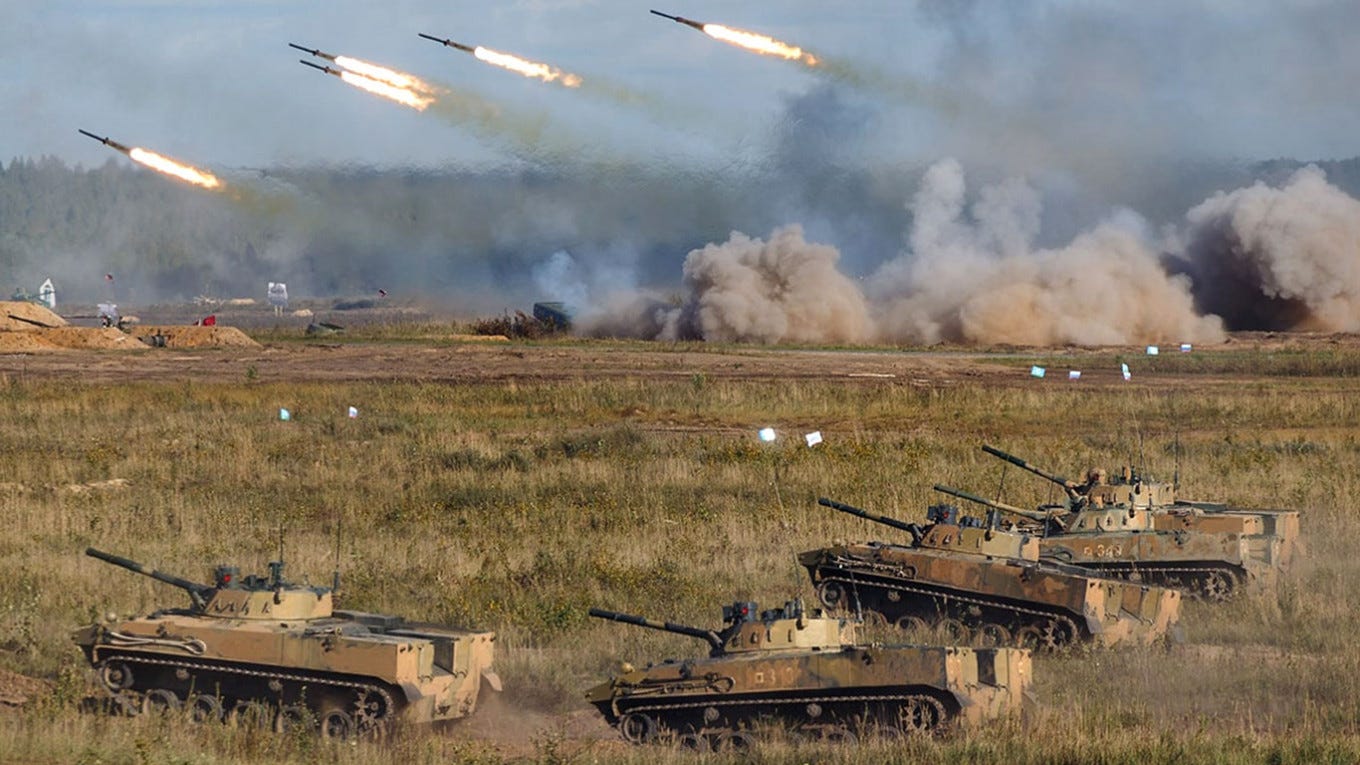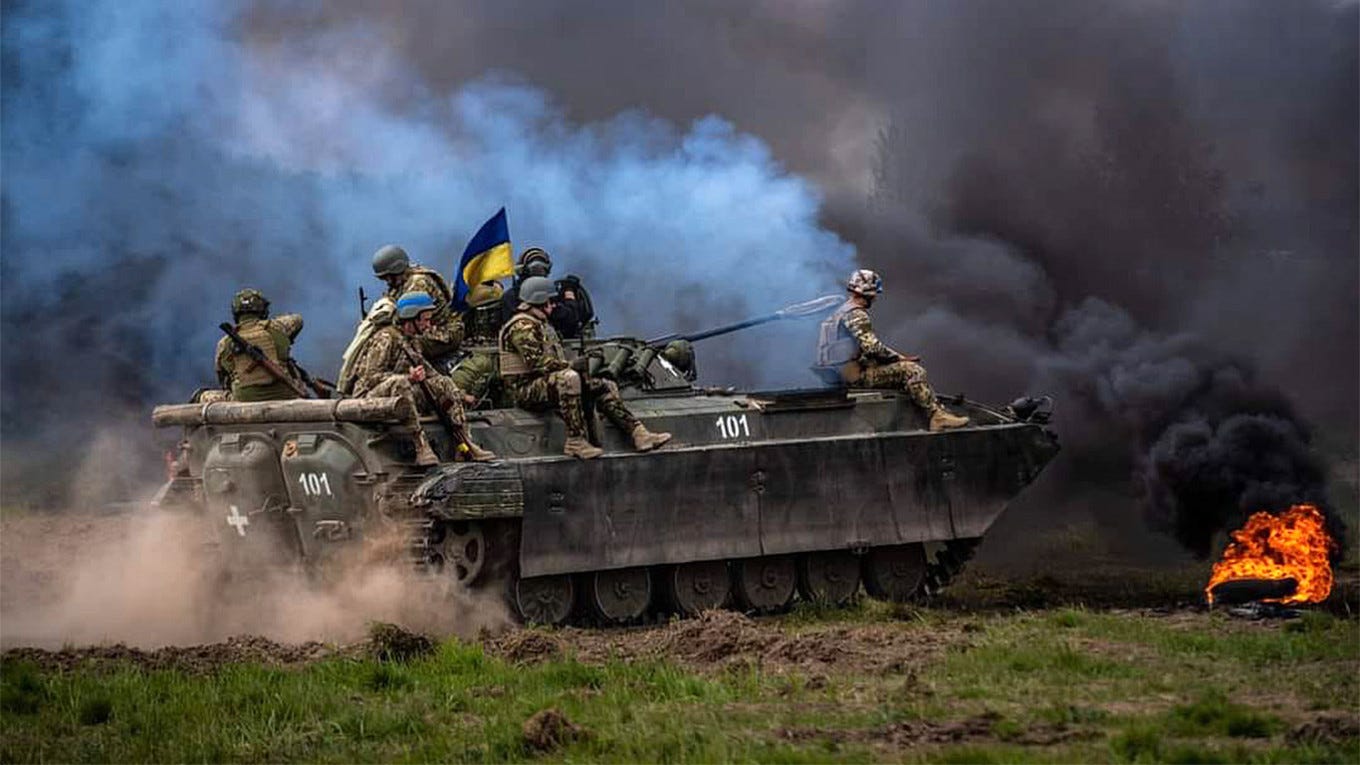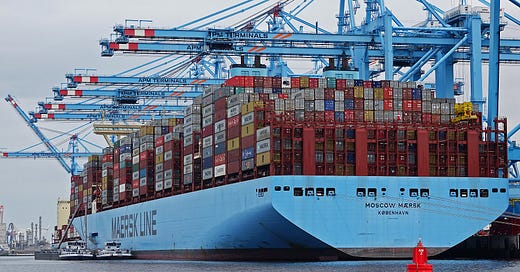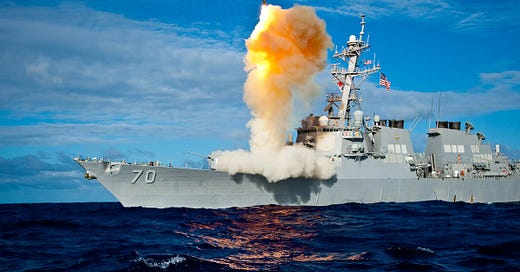

Discover more from Weapons and Strategy
In 2014 I wrote the article reprinted below asking the question, Will NATO Fight, Talk or Trade?
That was well before the Russian military operation in Ukraine that started in February, 2022.
It was also before Europe, the US and others imposed heavy sanctions on Russia. It was before Germany lost its cheap natural gas from Russia and willingly sacrificed its investments and trade as well.
Even so, most of the article describes what could be called the "ambiguities" of the NATO alliance, which was supposed to be a defensive alliance. Today NATO runs an aggressive military operation well beyond the borders of its member states.
Beyond that, NATO has put its members at great risk by significantly depleting its stocks of weapons including air defenses, tanks and infantry fighting vehicles, and ammunition. Reports say that if the Germans or the British got into an actual war, their supplies would run out in 10 days. For the purpose of reference, the Ukraine war has been raging for two years and two months.
That has not dampened the enthusiasm of some in Europe, Macron takes center stage, calling for NATO troops to be injected in Ukraine. NATO troops, of course, would have no particular advantages over their Ukrainian colleagues. In combat NATO would have to expect high casualties.
There has been a lot of press recently that Ukraine's big counter-offensive failed because the Ukrainians did not follow the guidance of their NATO big brothers. Had they done so, Ukraine would have been successful.
Yet the US-NATO plan was nutty from the get go. To fight a war without air cover and with spotty air defense systems which the Russians liquidated is not a plan that lends itself to success. The US and Western criticism also is an insult to the Ukrainian army that fought hard and sustained massive casualties.
In a conventional war in Europe, the US would need to hope that its stealth jets and bombers can "win" against the Russians (a capability Ukraine, of course, never had). That presumption overlooks Russian efforts to detect and shoot down stealth platforms which have been ongoing and it also underestimates Russian combat aircraft capabilities. Even more realistically, air power by itself is not going to win a land war. What the Russians may lack technologically, they have large stores of missiles and glide bombs while NATO lacks defenses against most of these weapons.
No one has any clear idea of what would happen if the European critical infrastructure is attacked. Without air defenses (which is generally the case in Europe and the United States), protecting command centers, military bases and staging areas, railroads, bridges, power plants and electricity transmission systems would be a huge challenge.
The key for NATO is to rethink its ability to defend Europe rather than focusing on operating on territory outside of NATO's boundaries. The waste of vital resources in Ukraine, for example, is undermining NATO's credibility to the degree that the public will lose confidence in the alliance and may seek to retreat from it. Ukraine too, however slowly, is starting to see that the NATO arsenal is empty and that NATO won't really fight when the chips are down, mostly because it cannot.
Here is my 2014 article that was published by the Jewish Policy Center.
Will NATO Fight, Talk or Trade?
Stephen Bryen • Fall 2014
With the end of the Cold War and the collapse of the Soviet Union and Warsaw Pact, the NATO alliance could have folded, and maybe should have folded with its raison d’etre gone. But not only did the alliance continue, it aggressively pursued an expanded membership base and broader non-member relationships under the Partnership Action Plan. Attempts to bring Ukraine and Georgia into NATO, and partnerships with Azerbaijan, Armenia, Kazakhstan, and Moldova caused considerable angst in Russia where they were seen treading on the Russian sphere of influence.
But as NATO has become wider, it has become shallower and less able to meet its own standards for the defense of its members. And a weak NATO may in fact be worse than no NATO at all, inviting aggression against it. Russia, for all its bluster, still fears NATO encirclement and does not trust the United States. Leaving NATO in a posture where it lacks any real ability to fight is the worst of all possible worlds.
NATO Has Been Busy
The NATO alliance has taken on a number of non-core missions since 1991.
In 1992, NATO entered the Bosnian-Serbian war and on February 28, 1994 U.S. F-16s, operating under NATO command, shot down four Serbian J-21 jets near Banja Luka, marking the first time in NATO’s history that the alliance engaged in actual combat. The allied bombing campaign and on-the-ground enforcement activities led to the Dayton Accords and a negotiated settlement, contingent on the presence of 60,000 NATO peacekeepers who remained in one form or another until 2004.
The Bosnia operation was extended to Kosovo with the stabilization force known as KFOR deriving its mandate from the UN Security Council and the Military-Technical Agreement between NATO and the Federal Republic of Yugoslavia and Serbia. In 2008, Kosovo declared independence from Serbia, an announcement strongly rejected by the Russians—although Russia used the Kosovo “precedent” as a justification for Crimea’s independence in 2014.
In 2003, NATO set up the International Security Assistance Force for Afghanistan to conduct security operations in that country. ISAF, too, was backed by the United Nations and consisted of both NATO and non-NATO countries. The largest contingent was American (30,700). Most countries provided only small numbers, with Britain (3,936) the only other country to exceed 1,000 personnel.
In 2011, NATO launched Operation Unified Protector in Libya, based on UN resolutions that imposed sanctions on key members of the Gaddafi government and authorized NATO to implement an arms embargo and no-fly zone, and to use all means necessary, short of foreign occupation, to protect Libyan civilians and civilian populated areas.
The recent NATO decision to create a “rapid reaction force” to protect Eastern Europe from Russia was created in response to the situation in the Ukraine.
Overall, NATO—in its new clothes—has conducted a number of military operations with mixed success. Its record overall is blemished by a number of unfortunate incidents including the massacre at Srebrenica that should have been prevented by Dutch peacekeeping forces; the bombing of a civilian train at Grdelica (300km south of Belgrade); and the “accidental” bombing of the Chinese embassy in Belgrade. Similar mistakes were made in Kosovo. In Afghanistan, airstrikes have killed many civilians, and the entire effort seems close to collapse as the U.S. prepares to withdraw. Gaddafi was ousted but today Islamists occupy Tripoli and the U.S. Embassy there.
What does it mean to be NATO?
NATO was formed in 1949 in response to the Russian-precipitated Czech crisis and denial of land access to Berlin in the Russian Occupation Zone. In response, the U.S. and its allies organized an airlift of supplies—the celebrated Berlin Airlift—that not only replaced supplies previously going by rail, but exceeded the amounts delivered under normal conditions. The result was the creation of two German states and the formal division of Berlin itself. And the Cold War in Europe.
At its inception, NATO included the U.S., Britain, Canada, France, Iceland, Italy, Luxembourg, Netherlands, Norway, and Portugal. In 1952, Greece and Turkey were added as both emerged from Soviet/Communist challenges, followed by The Federal Republic of Germany in 1955 and Spain in 1982. Since the collapse of the USSR, a number of Eastern European countries have been added. While France continued to participate in NATO’s political meetings, it removed itself from military participation between 1966 and 2009.
The key to NATO is collective defense, embodied in Article V of its Charter, which states that “an armed attack against one” state or more “shall be considered an attack against them all.” Moreover, member states each agree to “assist the Party or Parties so attacked by taking forthwith, individually and in concert with the other Parties, such action as it deems necessary, including the use of armed force.”
Because Article V can be exercised by any state individually and in concert with other Parties, no formal NATO approval is required—meaning that no single state could object to action under this Article. That is the best that can be said. Article V authorizes each state to respond “as it deems necessary” but there is no obligation for any state to respond and no assurance that all the states will respond.
No one can say what NATO would do under conditions of an actual attack. We do know that when the U.S. was attacked on September 11, 2001, it asked NATO to consider it to be an attack under Article V. NATO agreed that the United States was attacked but did not determine that the attack was directed from abroad. Therefore NATO did not see the 9/11 attacks on the U.S. as qualifying under Article V. Since 9/11 there have been a number of attacks on NATO member countries by terrorist organizations with clear foreign connections. NATO has remained inert.
Article V, furthermore, presumes that it is a state actor that leads the attack. As the Russians have amply demonstrated in Ukraine, non-state surrogates can always be used to accomplish state goals. While Russia’s backing of these non-state actors is clear, would that be enough to trigger a NATO response were Ukraine a NATO member? If the precedent of 9/11 is any guide, the answer is that such a surrogate attack would not qualify.
This is only one of the weaknesses in NATO’s collective defense agreement.
Another is that Article V allows for member states to decide what response is appropriate, whether military force or short of that. This is particularly important because presumed front line states, such as Poland or Estonia, could be exposed to political-military subversion, some of it involving armed violence, which under NATO rules would not trigger an Article V reaction.
The Bronze Soldier of Tallinn
The Bronze Soldier is a monument erected in September 1944 by then-Soviet controlled Estonian authorities commemorating the expulsion of the Nazis. Estonian nationalists regarded it as a symbol of Soviet occupation. In 2007, the now-independent Estonian government decided to relocate the monument, causing a bitter fight with Russians living in Estonia and with the Russian government.
On April 27, 2007, websites of Estonian organizations, including the parliament, banks, ministries, newspapers, and broadcasters, were hit by strong cyber attacks coming from Russia. Until then, the major example of an attack on parts of a country’s critical infrastructure was a three-year Chinese attack on American assets culminating in 2003. Called “Titan Rain” by the U.S. government, the attacks struck defense contractor computer networks.
The Estonia attacks were directly connected to political events. They damaged parts of the critical infrastructure and contained much that was new and unexpected. Certain hidden network locations for sensitive banking and finance systems and telecoms were identified and hit, which greatly surprised Estonian security authorities. Intending to demonstrate its ire toward the Estonian government, Russia also demonstrated that it could do considerable damage short of an actual military invasion.
At the time, the Russians had the option to cause much more trouble, even to the point of sponsoring local terrorist attacks. They did not do so then, but what about the future?
A cyber attack on critical infrastructure, even when the source is known (as it surely was in Estonia), is apparently not an attack under Article V because it is not what is conventionally thought of as an “armed attack.” Suppose, instead, the Russians decided to use an EMP attack (electro-magnetic pulse)? Would that be actionable under Article V? The truth is that NATO has never tested the definition of “armed attack,” while demonstrating a strange variability when it came to protecting the United States after 9/11.
Can NATO really Fight?
In 1953, the United States had over 450,000 soldiers overseas in NATO countries, spread across 1,200 different sites. Army, Air Force, Marine, and Naval forces presented a formidable obstacle and trip wire to any possible Soviet invasion of Western Europe, and certainly against an attack against a single country. By 1990, that number was reduced to 213,000 American military personnel, and over the next three years it was reduced to 122,000 troops. Today there are 64,000 American troops in Europe, mostly supporting U.S. operations elsewhere, including Afghanistan.
In addition, in 2013 the U.S. deactivated an A-10 ground attack jet fighter squadron from Germany. Also in 2013, the U.S. deactivated an Air Control Squadron from Italy, vital to U.S. operations in Africa and the Middle East. The 170th and the 172nd Brigade combat teams were deactivated in 2013 and 2014 respectively, removing all U.S. Army heavy armor capability from Europe.
These cutbacks may have been acceptable had intelligence supported the idea that Russia would not launch a land attack against NATO countries, as all the assets removed (not counting the soldiers) focused on protecting against a massed land attack. But the convoys of tank transporters moving heavy tanks, artillery and anti-aircraft systems moving into Ukraine from Russia indicates that they either intend to use these assets themselves or provide them to pro-Russia forces inside Ukraine. Ukraine could certainly be a dress rehearsal for other, even more provocative, operations.
The bottom line is that the American ability to support ground operations in Europe, should it be needed, is very limited. About the only response the U.S. could mount would use American aircraft already in Europe, of which there are not many.
Zapad 2013
Zapad (“West”) 2013 was a major Russia/Belarus military exercise that took place in September 2013. By combining anti-terrorist operations and urban warfare into major conventional operations, the exercise suggesed a renewed Russian focus on a large scale war doctrine. Most interestingly, Zapad 2013 featured the air transport of some 70,000 troops, a huge number considering that NATO’s answer to Zapad 2013, “Steadfast Jazz,” transported at most 6,000. Zapad 2013 deliberately did not show tactical nuclear weapons, but Russian doctrine is to back up its conventional forces with tactical nuclear weapons of various types including missile and artillery based systems.
Europe’s Economic Dependency
In deciding how NATO might respond to a rapidly expanding challenge, it is important to understand that Europe’s economic relationship with Russia has changed since the end of the Cold War. Europe’s energy dependency on Russia continues to grow, and Europe enjoys considerable export advantages to Russia and the former Soviet states.
Russia is Germany’s 11th biggest trading partner at more than $104 billion annually. Germany is also one of the biggest investors in Russia, putting in $22 billion last year. Most important, Germany is a big customer for Russian gas and oil, receiving over 35% of its supplies from Russia. According to surveys, Germans approve of the relationship with Russia and oppose sanctions on the Russian government. While NATO has put sanctions in place as a result of Ukraine, it is far from clear Germany will adhere to them.
Dependency on Russian energy exports, particularly natural gas, is very high for many European countries. Should an emergency result in the shutdown of these supplies, it would have a devastating impact on Europe’s already slumping economies.
This creates an advantage for Russia in assuring that NATO won’t respond strongly to challenges on the non-NATO periphery, such as Georgia or Ukraine. What would happen if the challenge was directed against a NATO member is harder to judge, but NATO members would struggle, given the potential economic and social consequences to their people. It would take a tremendous challenge to force the Europeans to respond militarily, and even then the capacity for a meaningful response is limited.
Such an assault would not be cost-free for Russia. Putin can continue to point out that Russia is a force to be reckoned with, but if he finds his tactics leading him to a real military confrontation, the long-term consequences are neither predictable nor optimistic insofar as Russia’s stability and integrity are concerned. That may prove small comfort to both sides if a weak NATO is forced to respond militarily to Russian aggression.

















Politicians and leaders who promote war should be the first to be sent to the front lines along with their families.
I have read in many places that NATO lacks resources for a war against Russia. So why are Macron and others expressing such bravado, unless they know something we don't?
I suppose "stupidity" is an answer, but I find it hard to believe that there is not one person in the French Ministry of Defense or military that cannot take Macron aside and tell him that his mouth is writing checks that his ass cannot cash.